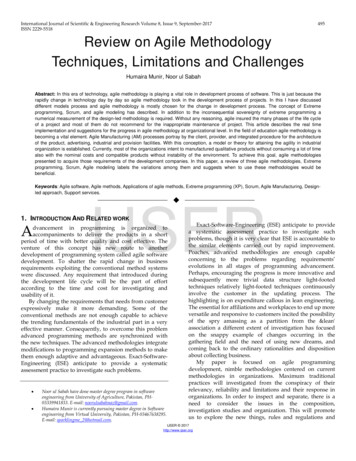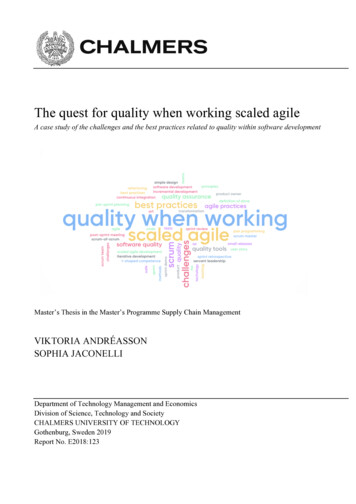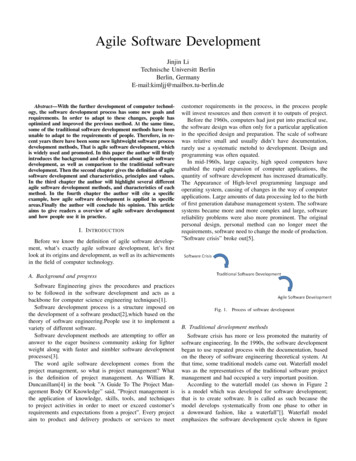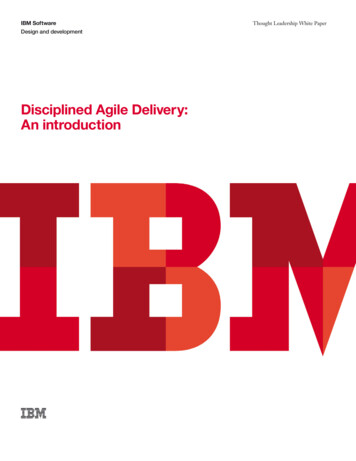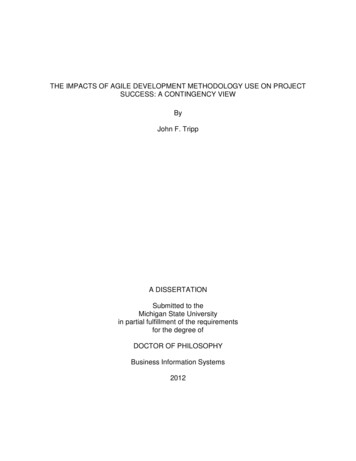
Transcription
THE IMPACTS OF AGILE DEVELOPMENT METHODOLOGY USE ON PROJECTSUCCESS: A CONTINGENCY VIEWByJohn F. TrippA DISSERTATIONSubmitted to theMichigan State Universityin partial fulfillment of the requirementsfor the degree ofDOCTOR OF PHILOSOPHYBusiness Information Systems2012
ABSTRACTTHE IMPACTS OF AGILE DEVELOPMENT METHODOLOGY USE ON PROJECTSUCCESS: A CONTINGENCY VIEWByJohn F. TrippAgile Information Systems Development Methodologies have emerged in thepast decade as an alternative manner of managing the work and delivery of informationsystems development teams, with a large number of organizations reporting theadoption & use of agile methodologies. The practitioners of these methodologies makebroad claims as to the benefits of their use. However, to date, only a few of these claimshave been tested in the research literature.Agile methodologies, including Extreme Programming, Scrum, and others,prescribe very different practices, some of which are contradictory. Additionally, the useof the practices of agile methodologies is not restricted to agile development projects,and has been observed in non-agile methodologies environments. Even so, theprevious research literature has usually focused on practices prescribed by a particularagile method. So what is different about agile methodologies, and what is theappropriate lens through which to study them?This dissertation finds that the most distinctive element of agile methodologies istheir strong emphasis on obtaining and processing feedback from the environment. Thisdissertation evaluates the impacts of agile methodologies as indicated by the use ofthese feedback processes.In this study, the theoretical lenses of team adaptation, organizational learning,and the prior literature on new product development are used to explain the importance
of a team’s ability to process repeated and continuous feedback from the environment.We motivate hypotheses regarding the positive impact of agile methodology use on amulti-dimensional construct representing project success. This construct encompassesthe quality of the delivered product, the benefits of the project to the organization, andimpacts on project management outcomes. In addition, the nature of moderatinginfluences of uncertainty on project success is discussed.The research design for the study utilized a survey that collected responses from83 agile development teams. Generalized linear modeling was used to test fourhypotheses regarding the impact of the extent of agile methodology use on projectsuccess, and the moderating influences of uncertainty. It was found that agilemethodology use positively impacts project success, while structural complexitynegatively moderates the impact of agile use. It was also found that environmentaldynamism positively moderated the impacts of agile methodologies on project success.Discussion of the results is provided.
Copyright byJohn F. Tripp2012
To my mother, Pamela Richman Tripp, and to my father and step-mother John F.Tripp, Sr. and Asya Lapidus; you have always supported my endeavors, without evercriticizing. To my in-laws, John & Susan McLennan, for the support and encouragementthat you show to your daughter’s husband and his crazy endeavors.To my children, Cayley Moriah, Joshua Lawrence Chamberlain, Zoe Elizabeth,Jonathan Edwards, Winston Churchill, Thomas Stonewall Jackson, and NormandyReagan. Forgive me for being too busy to hear you, for missing soccer games, formissing too many dinners with you. Your love for your very imperfect father kept megoing on many a long night’s work.Finally, to my wife, Molly Ann. No one is as incredible a help to her husband. Noone loves a husband with more faults. No one is more courageous and self-sacrificingfor her family. Without you, more than anyone else, my PhD could not have beencompleted. Thank you for marrying me, and thank you for the endless hours of puttingthe kids to bed alone, keeping the house alone, and teaching and instructing thechildren alone, all for the sake of my work.I dedicate this dissertation to you, my family, who I love very much.Soli Deo Gloria.v
ACKNOWLEDGEMENTSI would like to acknowledge the patience and guidance of my advisor, Dr. VallabhSambamurthy, who first implanted the idea of pursuing the PhD in my head, and whowas forced to listen to me discuss the idea of this dissertation for far too long before itbecame a “good” idea. Without his guidance and inspiration, I would not havecompleted this dissertation.Next, I would like to acknowledge the various faculty members who have,formally or informally, contributed to my completing the PhD process. First, I wish tothank the members of my committee, Dr. Roger Calantone, Dr. John Wagner, and Dr.BrianPentland, Ithankyou for your guidance, feedback,correction,andencouragement. I could not have asked for a better set of faculty to assist me in mythinking and direction for this dissertation. I would also like to acknowledge theassistance of Dr. D. Harrison McKnight, who spent significant time helping me craft thesurvey instrument, and gave me help with this project whenever I asked, even thoughhe was not a member of my committee.I would also like to acknowledge the support and assistance given to me byTeam Detroit, Inc., especially CFO Andy Weil and CIO James Weekley. Without theincredible flexibility afforded to me, and the support given to me during my first threeyears in the program, I could not have supported my family while also pursuing the PhDdegree. I also thank many of my co-workers at Team Detroit who provided me withmuch of the inspiration for this project, and who contributed advice and feedback. Ithank you all for your flexibility, enthusiasm, tolerance and support.vi
Finally, I would like to acknowledge the contribution and support of the agiledevelopment community, especially Ken Faw and John Birgbauer of Xede, RichSheridan of Menlo Innovations, Gary Gentry and Jay Aho of Pillar Technology, EugeneKeil and Chris Beale of Cengage Learning, Pat Reed of The Gap, and their many coworkers who helped me refine the ideas of this dissertation, and to identify avenues fordata gathering. Also, I would like to thank the membership of the Mid-Michigan AgileMeetup, the Michigan Agile Enthusiasts, and the Chicago Agile Methodology Group fortheir encouragement and support.Finally, I would like to acknowledge the many other people who lent supportduring this process, including the members of Providence PCA Church and OaklandHills Community Church. Your encouragement meant a great deal.vii
TABLE OF CONTENTSLIST OF TABLES . XILIST OF FIGURES . XIVCHAPTER ONE: INTRODUCTION AND OVERVIEW . 1INTRODUCTION. 1BACKGROUND . 7PURPOSE OF THIS STUDY . 9ORGANIZATION OF PRESENTATION . 10CHAPTER TWO: THEORETICAL MODEL AND SUPPORTING LITERATURE. 11INTRODUCTION. 11THE EVOLUTION OF METHODOLOGY - A QUEST FOR FIT . 13WHAT IS A SOFTWARE DEVELOPMENT METHODOLOGY? . 19Waterfall – Big Delivery . 21Agile Methodologies – Continuous Delivery . 25Definable vs. Empirical Processes . 27Agile Development – a Description . 30THE PRACTITIONER LITERATURE ON AGILE METHODOLOGIES . 34UNCERTAINTY: COMPLEXITY AND CHANGE . 42TEAM ADAPTABILITY & ORGANIZATIONAL LEARNING . 45Cue Recognition. 47Team Situational Awareness . 49Mutual Monitoring. 50SOFTWARE DEVELOPMENT AS NEW PRODUCT DEVELOPMENT . 52ADAPTABILITY, AGILE AND FEEDBACK CAPABILITIES . 54PROJECT SUCCESS . 56Project Management Metrics . 57Definitions of IS Success . 58CONTINGENCIES IN THE PROJECT ENVIRONMENT . 59THE COMPONENTS OF UNCERTAINTY AS CONTINGENT FACTORS . 60THE RESEARCH LITERATURE ON THE IMPACTS OF AGILE DEVELOPMENT . 63AGILE METHODOLOGIES: STRUCTURE AND IMPACTS . 76Agile Philosophy Adoption . 77Agile Management Control. 78Supporting Infrastructure Adoption. 78CHAPTER SUMMARY . 81CHAPTER THREE: RESEARCH MODEL . 82INTRODUCTION. 82RESEARCH MODEL AND VARIABLES . 82PROJECT SUCCESS . 86EXTENT OF AGILE METHOD USE . 88Reduced Up Front Planning . 88viii
Environmental Feedback . 89Iterative Delivery . 90Technical Feedback . 91UNCERTAINTY AND PROJECT SUCCESS . 93Structural Complexity . 93CONTROL VARIABLES . 99Project Size . 99Organization Size . 99Time since Agile Adoption . 99Team Member Skill . 100Team Member Agile Experience . 100CHAPTER SUMMARY . 100CHAPTER FOUR: RESEARCH METHODOLOGY . 102INTRODUCTION. 102CONSTRUCT OPERATIONALIZATION. 102Extent of Agile Method Use . 103Project Success . 105Control Variables. 108PRE-TESTING THE SURVEY . 109SAMPLE DESIGN AND DATA COLLECTION . 110CHAPTER SUMMARY . 115CHAPTER 5: ANALYSIS AND RESULTS. 116INTRODUCTION. 116Analysis Approach . 116EXTENT OF AGILE METHOD USE . 116OUTCOME VARIABLES . 118UNCERTAINTY . 121Dynamism . 121Complexity . 122ANALYSIS OF DATA CHARACTERISTICS. 127Tests for Normality . 127Tests for Unusual and Influential Data . 140Tests for Linearity. 142Transformation of Data . 143ANALYSIS RESULTS . 145TESTING THE RESEARCH MODEL . 147STRUCTURAL COMPLEXITY . 147Summary of results: Hypothesis 2a. 154TECHNICAL COMPLEXITY . 154Summary of results: Hypothesis 2b. 160DYNAMISM . 160Summary of results: Hypothesis 2c . 166Summary of results: Hypothesis 1. 166CHAPTER SUMMARY . 169ix
CHAPTER 6: DISCUSSION AND IMPLICATIONS OF THE RESULTS. 170INTRODUCTION. 170THE EFFECTIVENESS OF AGILE METHODOLOGIES IN SOFTWARE DEVELOPMENT . 170THE MODERATING EFFECTS OF UNCERTAINTY . 172LIMITATIONS OF THIS STUDY . 174IMPLICATIONS FOR PRACTICE . 175IMPLICATIONS FOR FUTURE RESEARCH . 177CONCLUSION . 179APPENDIX A: QUESTIONNARIE ITEMS . 181ITEMS FOR STRUCTURAL COMPLEXITY . 181ITEMS FOR PROJECT CRITICALITY . 182ITEMS FOR TECHNICAL COMPLEXITY . 182ITEMS FOR DYNAMISM . 183ITEMS FOR AGILE METHOD USE . 184ITEMS FOR PRODUCT QUALITY . 185ITEMS FOR ORGANIZATIONAL BENEFITS . 186ITEMS FOR PROJECT MANAGEMENT OUTCOMES . 186APPENDIX B: SUPPLEMENTAL DATA TABLES . 187REFERENCES . 191x
LIST OF TABLESTable 1.1. Anticipated Benefits of Agile Methodology Adoption (Version One 2010). . 5Table 1.2. Significant Agile Methodologies and Proponents. . 8Table 2.1. Summary of Generations of Development Methodologies . 14Table 2.2. Selected Definitions of Software Development Method[ology] . 20Table 2.3. Selected Definitions of “Agile/Agility” . 28Table 2.4. The 12 Principles of the Agile Manifesto . 37Table 2.5. Defined Practices of Major Agile Methodologies . 41Table 2.6. Standish CHAOS results . 58Table 2.7. Five Factors Determining Fit of Agile vs. Plan-Based Methodologies . 62Table 2.8. Recent Empirical Literature on Agile Methodologies . 67Table 2.9. Output control vs. emergent outcome control (Harris, 2009) . 72Table 3.1. Research Variable Definitions . 85Table 3.2. Summary of Hypotheses . 101Table 4.1. Sections of Questionnaire Presented to Each Respondent Type . 103Table 4.2. Items Indicating the Extent of Agile Method Use . 104Table 4.3. Items Indicating Project Management Success . 105Table 4.4. Items Indicating Product Quality . 107Table 4.5. Items Indicating Organization Benefits . 108Table 4.6. Demographics Breakdown of Respondents . 112Table 4.7. Missing Data Summary for 373 Cases . 114Table 5.1. Factor Loadings for the Dimensions of Agile Method Use . 117Table 5.2. Descriptive Statistics for Agile Use Items . 118Table 5.3. Factor Loading for Product Quality and Benefits Items . 119xi
Table 5.4. Descriptive Statistics for Product Quality and Benefits Items . 120Table 5.5. Factor Loadings for the Dimensions of Dynamism . 122Table 5.6. Descriptive Statistics for Uncertainty Items . 122Table 5.7. Factor Loadings for the Dimensions of Technical Complexity . 123Table 5.8. Descriptive Statistics for Technical and Structural Complexity Items . 124Table 5.9a. Second Order Factor Loadings: Quality . 124Table 5.9b. Second Order Factor Loadings: Technical Complexity . 124Table 5.9c. Second Order Factor Loadings: Agile Method Use . 125Table 5.9d. Second Order Factor Loadings: Dynamism. 125Table 5.10. Correlations and Variance Inflation Factors. 126Table 5.11. Shapiro-Wilk Test for Normality of Distribution . 128Table 5.12. Generalized Linear Models Used to Test Moderating Effects of Uncertainty. 148Table 5.13. Goodness of Fit of Model 3 the Moderation Effects of Structural Complexity. 149Table 5.14. Parameter Estimates for Model 3, the Moderation Effects of StructuralComplexity. . 150Table 5.15. Cases by Category – Structural Complexity . 151Table 5.16. Summary of Interaction Effects - Structural Complexity . 151Table 5.17. Nested Model Interaction Coefficients – Structural Complexity . 153Table 5.18. Goodness of Fit of Model 4. Moderation Effects of Technical Complexity. 156Table 5.19. Parameter Estimates for Model 4, the Moderation Effects of TechnicalComplexity. . 157Table 5.20. Cases by Category – Technical Complexity . 158Table 5.21. Summary of Interaction Effects - Technical Complexity . 158Table 5.22. Nested Model Interaction Coefficients – Technical Complexity . 159xii
Table 5.23. Goodness of Fit of Model 5, the Moderation Effects of Dynamism. . 162Table 5.24. Parameter Estimates for Model 5, the Moderation Effects of Dynamism. 163Table 5.25. Cases by Category – Dynamism . 164Table 5.26. Summary of Interaction Effects - Dynamism . 164Table 5.27. Nested Model Interaction Coefficients – Dynamism . 165Table 5.28. Summary of Hypothesis Findings . 168Table B.1. Response Breakdown by Team and Response Type . 187xiii
LIST OF FIGURESFigure 2.1. The “Waterfall” Method . 22Figure 2.2. The Cost Curve of Change Under The Waterfall Method . 24Figure 2.3. Agile Method Feedback Loop. 30Figure 2.4. The Cost of Change Curve Under Agile Method (Beck 1999) . 34Figure 2.5. The Nomological Network of Agile Method Adoption and Use . 77Figure 2.6. The Theoretical Model of The Impacts of Agile Method Adoption and Use onProject Success. . 80Figure 3.1: The Theoretical Model for Analyzing The Impacts of Agile Method Adoptionon Project Success . 84Figure 5.1a: Diagnostic Outputs for Quality - Histogram . 129Figure 5.1b: Diagnostic Outputs for Quality – Box Plot . 130Figure 5.1c: Diagnostic Outputs for Quality – Q-Normal Plot . 131Figure 5.1d: Diagnostic Outputs for Quality – Symmetry Plot . 132Figure 5.2a: Diagnostic Outputs for Agile Method Use - Histogram . 133Figure 5.2b: Diagnostic Outputs for Agile Method Use – Box Plot . 134Figure 5.2c: Diagnostic Outputs for Agile Method Use – Q-Normal Plot . 135Figure 5.2d: Diagnostic Outputs for Agile Method Use – Symmetry Plot . 136Figure 5.3a: Diagnostic Outputs for Dynamism - Histogram . 137Figure 5.3b: Diagnostic Outputs for Dynamism – Box Plot. 138Figure 5.3c: Diagnostic Outputs for Dynamism – Q-Normal Plot . 139Figure 5.3d: Diagnostic Outputs for Dynamism – Symmetry Plot . 140Figure 5.4. Matrix Plot of Factor Relationships. 141Figure 5.5. Spline Transformation Plots . 144xiv
Chapter One: Introduction And Overview“We are uncovering better ways of developing software bydoing it and helping others do it." – The Agile ManifestoIntroductionInformation system development methodologies (henceforth, IS developmentmethodologies) have been used over the past 50 years with the intent to both increasecontrol and reduce the uncertainty and risk of IS development projects (Avison andFitzgerald 1998; Hirschheim et al. 1995). IS projects have long been recognized asbeing difficult to define, manage, and deliver (e.g. - Barki et al. 2001; Keil 1995; Keil etal. 2000; Marakas and Elam 1998; Zmud et al. 1993). During its early years, softwaredevelopment was primarily an engineering concern. However, the systems developmentprocess context has increasingly become focused on the automation and support ofcore business processes. Therefore, development teams are being asked to adaptrapidly to changing technical, market, and user requirements (Conboy 2009), deliverbusiness value more quickly and to respond to change more (Lyytinen and Rose 2006).However, even with the benefit of 50 years of method evolution, projects often exceedbudget and time estimates, escalate for years, and regularly deliver far less thanoriginally promised (Keil 1995).IS development projects historically have been long-term efforts, deliveringsystems after months or even years. However, with the increasing pace of businesscompetition, traditional development project timelines have been criticized as taking toolong. Time pressures have escalated due to heightened competition and the escalatingspeed of technical innovation. This requires the software development process todeliver business value as quickly as possible. At the same time, software development1
teams are being asked to adapt to rapidly changing technical, market, and userrequirements. This pace of change must be managed without adversely impacting teamperformance.Multiple software development methodologies have emerged in the last fourdecades of the twentieth century. At first, these methodologies emerged in response tothe need to control and standardize the development process. Developmentmethodologies continued to evolve to address issues related to growing systems wever,whilethesemethodologies have evolved for more than 50 years, project failure rates continue to beextremely high (Standish Group, 2009). Project timetables continue to be long, flexibilityis low, and the delivery of business value is usually achieved at the end of the project, ifat all.The latest generation of development methodologies, known as “agile”methodologies, have emerged over the past two decades (Beck and Andres 2004;Conboy 2009). These methodologies claim to be able to better handle the dynamicnature of the business environment (Boehm and Turner 2004; Cockburn 2001;Highsmith 2002; Schwaber 1996). Agile development methodologies share keyphilosophical underpinnings. These include the early and continuous delivery ofsoftware, the embracing and creating of change, the cultivation of empowered teams,and the delivery of simple solutions.Agile development methodologies are different from traditional methodologies inseveral key ways. First, traditional methodologies usually planned to use 33% or moreof the project duration in the planning phase (PMBOK 2000). In contrast, agile2
methodologies recommend a maximum of 10% of anticipated project time to be spenton up front planning (Anderson 2004; Coad et al. 1999; Highsmith 2002), and mostrecommend much less. Second, most traditional methodologies usually planned todelivered the project system at the end of the project. In co
THE IMPACTS OF AGILE DEVELOPMENT METHODOLOGY USE ON PROJECT SUCCESS: A CONTINGENCY VIEW By John F. Tripp Agile Information Systems Development Methodologies have




